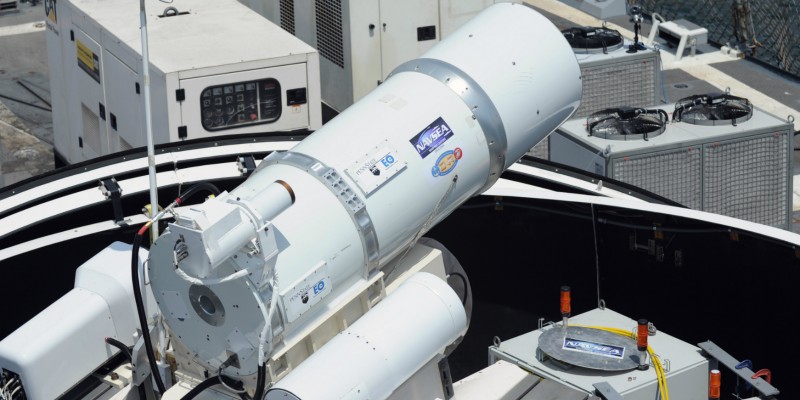On the opening day of this year’s Sea Air Space Expo, the wonder con for all things naval aviation, the U.S. Naval Sea Systems Command announced a planned 2014 deployment of its long-awaited, functional solid state Laser Weapon System (LaWS). Scheduled for installation aboard the amphibious transport dock, USS Ponce, the production of an operational energy weapon system represents a huge success for the Office of Naval Research and a commitment to the ongoing development of directed energy initiatives. While not quite the colorful ray gun blaster from a million different science fiction paperback covers, the LaWS, developed at the U.S. Naval Research Laboratory, is a practical and economic game changer in aviation warfare.
In the Navy’s press release, Chief of Naval Research Rear Adm. Matthew Klunder states that:
This capability provides a tremendously affordable answer to the costly problem of defending against asymmetric threats, and that kind of innovative approach is crucial in a fiscally constrained environment. Our conservative data tells us a shot of directed energy costs under $1. Compare that to the hundreds of thousands of dollars it costs to fire a missile, and you can begin to see the merits of this capability.
Tested in July 2012, using a LaWS system installed aboard the guided missile destroyer the USS Dewey, with tracking and sighting provided by MK15 Phalanx Close-In RADAR, the Navy demonstrated the directed energy system against a moving surface combatant ship and a drone aircraft flying from a classified distance. Reminiscent of a magnifying glass using the sun to burn a piece of paper, footage provided by the Navy shows the unmanned aircraft under attack from the solid-state laser system, briefly smoldering, and then bursting into flame, destroying the craft.
Peter A. Morrision, program officer for ONR’s Sold-State Laser Technology Maturation Program, makes the point that not only are these types of electronic weapons systems highly economical, but they also reduce the risk to sailors aboard ships because they don’t require propellants or explosives to function. If you’ve ever walked past the magazine deck on an aircraft carrier, that’s something you can’t help but think is a good idea. Aboard the USS Ponce, the LaWS system functions inside of a fleet layered reaction containment sphere, along with conventional systems, providing coverage against small boats and a variety of aerial targets. Engineers are using the deployment on the Ponce to test system ruggedness while continuing work on increasing effective distance.
From an ethical perspective, one of the most notable strengths to the LaWS is the ability to control the intensity of the attack, allowing for a variety of responses, not all of which are lethal. A weapon that leaves the user with the ability to stop an enemy instead of killing them is of course the moral soldier’s dream weapon. The use of deadly force has its called for times, but having the option to disable instead is certainly appealing.
Economical, dependable, able to be operated by any reasonably trained sailor, these systems are well summed up by Morrison when he says, “The future is here. The solid-state laser is a big step forward to revolutionizing modern warfare with directed energy, just as gunpowder did in the era of knives and swords.”
The LaWS is another example of the ongoing, mostly unnoticed by the general public, revolution in military technology that has been going on at an astonishing rate over the last 12 years. When you consider the inexpensive, high-speed response provided by laser weapons against small aerial targets, tied into the same types of tracking system used in systems such as the Israeli Iron Dome technology, we’re witnessing the rise of a totally new type of defense that we shouldn’t have the hubris to say is unbeatable. It’s safe to say that LaWS will makes successful air attacks that much harder.






Comments are closed.